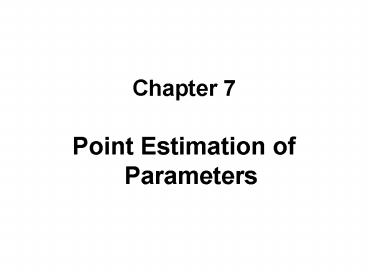Point Estimation of Parameters - PowerPoint PPT Presentation
Title:
Point Estimation of Parameters
Description:
Chapter 7 Point Estimation of Parameters Learning Objectives Explain the general concepts of estimating Explain important properties of point estimators Know how to ... – PowerPoint PPT presentation
Number of Views:99
Avg rating:3.0/5.0
Title: Point Estimation of Parameters
1
Chapter 7
- Point Estimation of Parameters
2
Learning Objectives
- Explain the general concepts of estimating
- Explain important properties of point estimators
- Know how to construct point estimators using the
method of maximum likelihood - Understand the central limit theorem
- Explain the important role of the normal
distribution
3
Statistical Inference
- Used to make decisions or to draw conclusions
about a population - Utilize the information contained in a sample
from the population - Divided into two major areas
- parameter estimation
- hypothesis testing
- Use sample data to compute a number
- Called a point estimate
4
Statistic and Sampling Distribution
- Obtain a point estimate of a population parameter
- Observations are random variables
- Any function of the observation, or any
statistic, is also a random variable - Sample mean and sample variance are statistics
- Has a probability distribution
- Call the probability distribution of a statistic
a sampling distribution
5
Definition of the Point Estimate
- Suppose we need to estimate the mean of a single
population by a sample mean - Population mean, ?, is the unknown parameter
- Estimator of the unknown parameter is the sample
mean - is a statistic and can take on any value
- Convenient to have a general symbol
- Symbols are used in parameter estimation
- Unknown population parameter id denoted by
- Point estimate of this parameter by
- Point estimator is a statistic and is denoted by
6
General Concepts of Point Estimation
- Unbiased Estimator
- Estimator should be close to the true value of
the unknown parameter - Estimator is unbiased when its expected value is
equal to the parameter of interest - Bias is zero
- Variance of a Point Estimator
- Considering all unbiased estimators, the one with
the smallest variance is called the minimum
variance unbiased estimator (MVUE) - MVUE is most likely estimator that gives a close
value to the true value of the parameter of
interest
7
Standard Error
- Measure of precision can be indicated by the
standard error - Sampling from a normal distribution with mean ?
and variance ?2 - Distribution of is normal with mean ? and
variance ?2/n - Standard error of
- Not know ?, we will substitute the s into the
above equation
8
Mean Square Error (MSE)
- It is necessary to use a biased estimator
- Mean square error of the estimator can be used
- Mean square error of an estimator is difference
between the estimator and the unknown parameter
- An estimator is an unbiased estimator
- If the MSE of the estimator is equal to the
variance of the estimator - Bias is equal to zero
Eq.7-3
9
Relative Efficiency
- Suppose we have two estimators of a parameter
with their corresponding mean square errors - Defined as
- If this relative efficiency is less than 1
- Conclude that the first estimator give us a more
efficient estimator of the unknown parameter than
the second estimator - Smaller mean square error
10
Example
- Suppose we have a random sample of size 2n from a
population denoted by X, and E(X) ? and V(X) ?2 - Let
- be two estimators of ?
- Which is the better estimator of ? Explain your
choice.
11
Solution
- Expected values are
- and are unbiased estimators of ?
- Variances are
- MSE
- Conclude that is the better estimator with
the smaller variance
12
Methods of Point Estimation
- Definition of unbiasness and other properties do
not provide any guidance about how good
estimators can be obtained - Discuss the method of maximum likelihood
- Estimator will be the value of the parameter that
maximizes the probability of occurrence of the
sample values
13
Definition
- Let X be a random variable with probability
distribution f(x?) - ? is a single unknown parameter
- Let x1, x2, , xn be the observed values in a
random sample of size n - Then the likelihood function of the sample
- L(?) f(x1?). f(x2?). f(xn?)
14
Sampling Distribution of Mean
- Sample mean is a statistic
- Random variable that depends on the results
obtained in each particular sample - Employs a probability distribution
- Probability distribution of is a sampling
distribution - Called sampling distribution of the mean
15
Sampling Distributions of Means
- Determine the sampling distribution of the sample
mean - Random sample of size n is taken from a normal
population with mean ? and variance ?2 - Each observation is a normally and independently
distributed random variable with mean ? and
variance ?2
16
Sampling Distributions of Means-Cont.
- By the reproductive property of the normal
distribution - X-bar has a normal distribution with mean
- Variance
17
Central Limit Theorem
- Sampling from an unknown probability distribution
- Sampling distribution of the sample mean will be
approximately normal with mean ? and variance
?2/n - Limiting form of the distribution of
- Most useful theorems in statistics, called the
central limit theorem - If n ? 30, the normal approximation will be
satisfactory regardless of the shape of the
population
18
Two Independent Populations
- Consider a case in which we have two independent
populations - First population with mean ?1 and variance ?21
and the second population with mean ?2 and
variance ?22 - Both populations are normally distributed
- Linear combinations of independent normal random
variables follow a normal distribution - Sampling distribution of is
normal with mean - and variance































